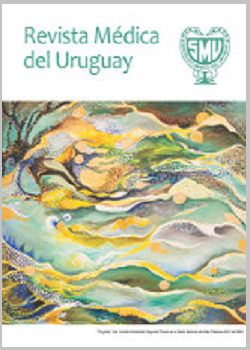Urachal carcinoma, a rare malignant neoplasm
Abstract
Urachal carcinoma is a rare malignant neoplasm of male predominance between the fifth to sixth decade of life. It is typically located in the dome of the bladder, with a predominant histopathological pattern of adenocarcinoma in 90% of cases. It has an indolent course with clinical manifestations in late stages characterized by hematuria, abdominal pain, dysuria, mucosuria, among others. Diagnosis is based on the finding of the lesion by endoscopic and imaging techniques. Given the infrequent nature of this pathology, we describe the case of a female patient in her fourth decade of life with recurrent urinary tract infection, who was documented by MSCTU of bladder polyp resected by TURP with a histological report of enteric-type adenocarcinoma.
References
(1) Reuter V. The urothelial tract: renal pelvis, ureter, urinary bladder and urethra. Philadelphia: Lippincott-Williams and Wilkins; 2004: 2062-3.
(2) Gopalan A, Sharp DS, Fine SW. Urachal carcinoma: a clinicopathologic analysis of 24 cases with outcome correlation. Am J Surg Pathol 2009; 33:659-68.
(3) Szarvas T, Módos O, Niedworok C, Reis H, Szendröi A, Szász M, et al. Clinical, prognostic, and therapeutic aspects of urachal carcinoma: a comprehensive review with meta-analysis of 1,010 cases. Urol Oncol 2016; 34(9):388-98.
(4) Behrendt M, Jong J, Rhijn V. Urachal cancer: contemporary review of the pathological, surgical, and prognostic aspects of this rare disease. Minerva Urol Nefrol 2016; 68(2):172-84.
(5) Quan J, Pan X, Jin L, He T, Hu J, Shi B, et al. Urachal carcinoma: report of two cases and review of the literatura. Molecular and clinical oncology. 2017; 6:101-4.
(6) Cruz P, Ramírez M, Iborra I, Rubio J, Pinto F, Gómez-Ferrer A, et al. Adenocarcinoma de uraco: ¿qué tanto sabemos? Rev Mex Urol 2014; 74:301-7.
(7) Jung H, Sun J, Park S, Kwon Y, Lim H. Treatment outcome and relevance of palliative chemotherapy in urachal cancer. Chemotherapy 2014; 60:73-80.
(8) Zeman M, Silver E, Akin E. CT and PET findings for urachal adenocarcinoma: a case report. Ann Clin Case Rep 2017; 2:1252.
(9) Hayashi T, Yuasa T, Uehara S, Inoue Y, Yamamoto S, Masuda H, et al. Clinical outcome of urachal cancer in Japanese patients. Int J Clin Oncol 2016; 21:133-8.
(10) Sheldon C, Clayman R, González R, Williams R, Fraley E. Malignant urachal lesions. J Urol 1984; 131:1-8.
(11) Kumar N, Khosla D, Kumar R, Mandal A, Saikia U, Kapoor R, et al. Urachal carcinoma: clinicopathological features, treatment and outcome. J Cancer Res Ther 2014; 10(3):571-4.
(12) Ashley R, Inman B, Sebo T, Leibovich B, Blute M, Kwon E, et al. Urachal carcinoma: clinicopathologic features and long-term outcomes of an aggressive malignancy. Cancer 2006; 107:712-20.
(13) Pinthus J, Haddad R, Trachtenberg J, Holowaty E, Bowler J, Herzenberg A, et al. Population based survival data on urachal tumors. J Urol 2006; 175:2042-7.
(14) Niedworok C, Panitz M, Szarvas T, Reis H, Reis AC, Szendröi A, et al. Urachal carcinoma of the bladder: impact of clinical and immunohistochemical parameters on patients' prognosis. J Urol 2016; 195(6):1690-6.













